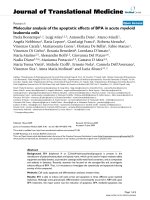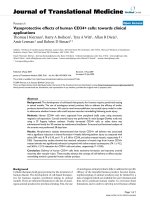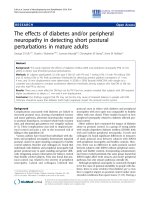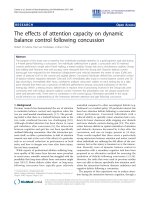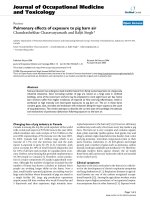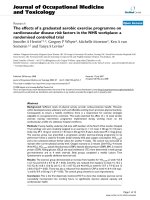báo cáo hóa học: " Pulmonary effects of exposure to pig barn air" ppt
Bạn đang xem bản rút gọn của tài liệu. Xem và tải ngay bản đầy đủ của tài liệu tại đây (242.11 KB, 4 trang )
BioMed Central
Page 1 of 4
(page number not for citation purposes)
Journal of Occupational Medicine
and Toxicology
Open Access
Review
Pulmonary effects of exposure to pig barn air
Chandrashekhar Charavaryamath and Baljit Singh*
Address: Department of Veterinary Biomedical Sciences and Immunology Research Group, University of Saskatchewan, Saskatoon, SK S7N 5B4,
Canada
Email: Chandrashekhar Charavaryamath - ; Baljit Singh* -
* Corresponding author
Abstract
Swine production has undergone rapid transformation from family owned operation to a large scale
industrial enterprise. Since increasing number of pigs are reared on a large scale in confined
buildings, some of the swine barn workers may be employed to work eight hours per day. Swine
barn workers suffer from higher incidences of impaired air flow and lung inflammation, which is
attributed to high intensity and interrupted exposures to pig barn air. The air in these barns
contains gases, dust, microbes and endotoxin with endotoxin being the major suspect as the cause
of lung dysfunction. This review attempts to describe the current state of knowledge of incidences
and mechanisms of pulmonary dysfunction following exposure to the barn air.
Changing face of pig industry in Canada
Canada is among the top five pork exporters of the world
with a total pork export of 970,000 tons in the year 2004,
which translates into cash receipts of $4.2 billion in the
year 2004 representing a 25% increase over the year 2003.
In 2005, Canada had 14.9 million hogs which is an
increase of 1.7% over the previous year and the pork
export is expected to grow by 2% [1,2]. Currently, pork
sector accounts for 30% of total livestock shipments and
for 10% of all farm cash receipts in Canadian farm econ-
omy. Further, swine farming has provided employment to
10,790 people in Canada [3]. Therefore, swine produc-
tion is a major component of Canada's agricultural econ-
omy. Although the number of pigs has increased but the
number of farms has shown a decline to indicate fewer
people are working longer shifts on the farms. Now a
days, small family operated pig farms are making way for
large scale facilities where thousands of pigs are raised in
a single facility [4]. Large pig production operations
require many full time workers who work 8 hour/day and
5 days/week and thus experience high intensity inter-
rupted exposures to the barn air [5,6]. However, still many
workers may work only a few hours every day inside a pig
barn. The barn air is very complex and contains organic
dust, plant materials (pollen grains, feed grains, hay and
silage), animal origin materials (swine dander, hair, urine
and pig proteins), microbial components (mite or their
parts, bacteria, endotoxin, (1–3) β-D-glucan and fungal
spores) and a number of gases such as ammonia, carbon
dioxide, hydrogen sulphide and methane [7-9]. Therefore,
although modern barns appear cleaner, the air inside
these barns still carries toxic molecules which are harmful
to the workers [10].
Clinical symptoms
Exposure to the toxic molecules in the barn air is a risk fac-
tor for the development of chronic respiratory symptoms
and lung dysfunction [11]. Respiratory diseases in agricul-
tural farmers are one of the earliest recognized occupa-
tional hazards [12]. Among the agriculture workers, swine
farmers report higher prevalence of occupational respira-
tory symptoms than in other farmers [13]. Exposed work-
Published: 06 June 2006
Journal of Occupational Medicine and Toxicology 2006, 1:10 doi:10.1186/1745-6673-1-10
Received: 06 February 2006
Accepted: 06 June 2006
This article is available from: />© 2006 Charavaryamath and Singh; licensee BioMed Central Ltd.
This is an Open Access article distributed under the terms of the Creative Commons Attribution License ( />),
which permits unrestricted use, distribution, and reproduction in any medium, provided the original work is properly cited.
Journal of Occupational Medicine and Toxicology 2006, 1:10 />Page 2 of 4
(page number not for citation purposes)
ers report significantly higher frequencies of respiratory
symptoms, chest illness, cold and pneumonia [7,14]. The
severity of respiratory symptoms in the workers increases
during the winter due to the reduced ventilation and is
also related to the number of working hours [15].
Previous studies have recorded reductions in expired flow
rates in barn workers [11][16-19]. Further, barn workers
also exhibit increased airway responsiveness and airway
inflammation [20,21]. The longitudinal decline in lung
function in swine barn workers has been linked to air con-
taminants [22] and a dose-response relationship exists
between decline in lung function and endotoxin and
ammonia levels in the barn air [17]. Exposure to the barn
organic dust causes airway inflammation and increased
airway resistance both in humans and animal models
apart from contributing to the exacerbation of asthma
[23-27]. These observations show that the barn air con-
tains toxic molecules which induce lung dysfunction in
pig barn workers.
Effects of acute single exposure to the swine
barn air: human studies
To better understand the negative effects of exposure to
swine barn air, many researchers have exposed naïve,
healthy volunteers to the swine barn air for a short period
of time (2–5 hours, once). This study model mimics the
lung response of new workers following first exposure to
the swine barn air. Single two-five hours of exposure of
naïve, healthy volunteers to swine barn air is shown to
induce bronchial responsiveness [28], fever, malaise and
drowsiness [21]. Across the shift change in lung function
during exposure is an important predictor of longitudinal
changes in lung function in swine confinement workers
[29]. Further, a 75-fold increase in neutrophils, a two-
three fold increase in mononuclear cells and a significant
increase in eosinophils, fibronectin and albumin levels in
bronchoalveolar lavage fluid (BALF) [21] and levels of IL-
1β, IL-1 receptor antagonist, IL-6 and TNF-α increased in
the serum of the exposed naïve volunteers. The changes in
IL-1 receptor antagonist levels correlated with changes in
FEV1, bronchial responsiveness, oral temperature and
white blood cell count while IL-1β levels correlated with
oral temperature [30]. Further, it is shown that, a single
exposure to barn air also caused thickening of nasal
mucosa, increased numbers of neutrophils in nasal lavage
and BALF, increased numbers of macrophages, lym-
phocytes, eosinophils and the levels of IL-8 in the BALF
[31,10]. Interestingly, levels of IL-8, a potent chemoat-
tractant for neutrophils, correlated with increase in neu-
trophils in the nasal lavage fluid [31]. It is obvious that
single exposure to the barn air can activate an inflamma-
tory response in human lungs.
Animal exposure studies
Although data from studies involving human volunteers
has shown induction of lung inflammation following
exposure to the barn air, animal studies are critically
needed to better understand cell and molecular changes.
So far, there have been very few animal model studies to
map the mechanisms of barn air-induced lung dysfunc-
tion. For example, rabbits and guinea pigs maintained for
12 months in a confined nursery-grower unit showed dif-
fuse interstitial histiocytic pneumonia, epithelial hyper-
plasia and metaplasia of tracheal and nasal turbinates,
with sub mucosal infiltration of plasma cells and heter-
ophils [32]. Interestingly, blood from these test animals
contained serum precipitins to dust extract from the swine
confinement building [32].
To mimic the work schedule at modern pig barns, we
exposed Sprague-Dawley rats to pig barn air for a period
of 8 hours/day for one day, 5 days or 20 days. The expo-
sures were interrupted for 2 days after each 5 days of 8
hour/day exposure and rats were kept in clean air during
this interruption. Rats exposed to the swine barn air for
one or five times showed increase in airway hyperrespon-
siveness compared to those exposed 20 times or controls.
Lungs from all the three exposed groups (one, five and 20
day) were inflamed with recruitment of neutrophils and
eosinophils in five and 20 day exposed groups. [33]. These
responses are similar to those observed in human volun-
teers exposed to the barn air for 3–5 hours [28,34,35].
Interestingly, airway reactivity in rats following 20 expo-
sures was not different compared to the controls to sug-
gest physiological adaptation to the pig barn air.
Similarly, following single exposure to the barn air, swine
farmers only show minor alterations compared to naïve
volunteers to suggests adaptation [36,37]. It is possible
that adaptation in animal models may be induced follow-
ing exposures shorter than 8 hours.
Because we found high concentrations of endotoxin in the
barn air, it may be central protagonist in initiating lung
inflammation in the exposed animals. These data show
that rat lung responses to the barn air are similar to those
in humans and that rat may be a reliable model to simu-
late lung dysfunction in humans following exposure to
the barn air [33].
In vitro studies on the effects of swine barn dust
Several researchers have shown the inflammatory poten-
tial of swine barn dust or air in many in vitro experiments
[38-40]. These in vitro studies are a valuable tool to under-
stand the effects of swine barn air or dust on a variety of
lung cells. These studies provide an opportunity to control
various variables to facilitate identification of cellular and
molecular pathways that regulate response to swine barn
air. Swine dust induces release of IL-8 in normal human
Journal of Occupational Medicine and Toxicology 2006, 1:10 />Page 3 of 4
(page number not for citation purposes)
bronchial epithelial cells, human pulmonary epithelial
carcinoma cell line (A549) and in human alveolar macro-
phages [38]. Swine dust is almost as potent as lipopolysac-
charides in stimulating cytokine release from alveolar
macrophages in vitro [39]. Recent data showed that swine
barn dust activates protein kinase C to induce secretion of
IL-8 and IL-6 from airway epithelial cells and promotes
adhesion of lymphocytes through upregulation of ICAM-
1 [40,41]. Swine barn dust can also directly activate T-lym-
phocytes [42]. These data show importance of performing
in vitro studies along with human and experimental ani-
mal investigations to further our understanding of lung
responses to pig barn air.
Conclusion and future studies
The data from animal and human studies show that barn
air can induce lung dysfunction. Recent data from animal
studies and from in vitro studies have started to elucidate
mechanisms of lung dysfunction induced following expo-
sure to the barn air. However, many questions remain
unanswered. One of the central questions relates to pre-
cise and relative contributions of various toxic molecules
in the barn air to lung dysfunction. The endotoxin is the
foremost toxic agent in the barn air. The role of endotoxin
in barn air induced lung dysfunction can be assessed
through the use of mice that lack a functional Toll-like
receptor-4. Second logical experiment is the physical and
biochemical characterization of the dust particles in the
barn air. Specifically, we need to know if the barn air con-
tains dust particles which are less then 100 nm in size
because particles of this size are believed to provoke a vig-
orous cardiopulmonary response [43,44]. The biochemi-
cal characterization of the particles would reveal if
particles are used as Trojan horse to carry endotoxins and
other toxic molecules into the lungs.
Competing interests
The authors declare that they have no competing interests.
Authors' contributions
Both the authors contributed equally in the preparation of
this review.
Acknowledgements
The work done in the authors' laboratory was supported through grants
from Saskatchewan Lung Association and Natural Sciences and Engineering
Research Council of Canada to Dr. Singh. Dr. Charavaryamath is supported
through Graduate Merit Scholarship from University of Saskatchewan
(2002–2004) and a scholarship from the CIHR Strategic Training Program
in Public Health and the Agricultural Rural Ecosystem (PHARE) and Partner
Institutes including the Institute of Cancer Research, Institute of Circula-
tory and Respiratory Health, Institute of Infection and Immunity, Institute
of Population and Public Health and the University of Saskatchewan. We
regret that due to space constraints we may not have cited a few worthy
publications.
References
1. World Pork Meat and Swine Trade Overview 2006 [http://
www.fas.usda.gov/dlp/circular/2005/05-04LP/porkoverview.pdf].
2. Hog Statistics 2006 [ />010-XIE/23-010-XIE2005004.pdf]. Statistics Canada, Agriculture Divi-
son
3. Farm operators by farm type, by province ( 2001 Census of
Agriculture) ( Canada) 2001 [ />agrc22a.htm].
4. Cole D, Todd L, Wing S: Concentrated swine feeding opera-
tions and public health: a review of occupational and com-
munity health effects. Environ Health Perspect 2000, 108:685-699.
5. Wenger I: Air Quality and Health of Career Pig Barn Work-
ers. Advances in Pork Production 1999, 10:93-101.
6. Wenger II, Ouellette CA, Feddes JJ, Hrudey SE: The design and use
of the Personal Environmental Sampling Backpack (PESB II)
for activity-specific exposure monitoring of career pig barn
workers. J Agric Saf Health 2005, 11:315-324.
7. Asmar S, Pickrell JA, Oehme FW: Pulmonary diseases caused by
airborne contaminants in swine confinement buildings. Vet
Hum Toxicol 2001, 43:48-53.
8. Donham KJ, Popendorf W, Palmgren U, Larsson L: Characteriza-
tion of dusts collected from swine confinement buildings. Am
J Ind Med 1986, 10:294-297.
9. Donham KJ, Popendorf WJ: Ambient levels of selected gases
inside swine confinement buildings. Am Ind Hyg Assoc J 1985,
46:658-661.
10. Cormier Y, Israel-Assayag E, Racine G, Duchaine C: Farming prac-
tices and the respiratory health risks of swine confinement
buildings. Eur Respir J 2000, 15:560-565.
11. Zejda JE, Hurst TS, Rhodes CS, Barber EM, McDuffie HH, Dosman JA:
Respiratory health of swine producers: Focus on young
workers. Chest 1993, 103:702-709.
12. Schenker MB, Christiani D, Cormier Y, Dimich-Ward H, Doekes G,
Dosman JA: Respiratory health hazards in agriculture. Volume
158. Edited by: Schenker MB. American Thoracic Society;
1998:S1-S76.
13. Iversen M, Dahl R, Korsgaard J, Hallas T, Jensen EJ: Respiratory
symptoms in Danish farmers: an epidemiological study of
risk factors. Thorax 1988, 43:872-877.
14. Zejda JE, Barber E, Dosman JA, Olenchock SA, McDuffie HH, Rhodes
C, Hurst T: Respiratory health status in swine producers
relates to endotoxin exposure in the presence of low dust
levels. J Occup Med 1994, 36:49-56.
15. Iversen M, Kirychuk SP, Drost H, Jacobson L: Human health
effects of dust exposure in animal confinement buildings. J
Agric Saf Health 2000, 6:283-288.
16. Donham KJ, Zavala DC, Merchant JA: Respiratory symptoms and
lung function among workers in swine confinement build-
ings: a cross-sectional epidemiological study. Arch Environ
Health 1984, 39:96-101.
17. Dosman JA, Graham BL, Hall D, Pahwa P, McDuffie HH, Lucewicz M,
To T: Respiratory symptoms and alterations in pulmonary
function tests in swine producers in Saskatchewan: results of
a survey of farmers. J Occup Med 1988, 30:715-720.
18. Bongers P, HJouthuijs D, Remijn B, Brouwer R, Biersteker K: Lung
function and respiratory symptoms in pig farmers. Br J Ind
Med 1987, 44:819-823.
19. Haglind P, Rylander R: Occupational exposure and lung function
measurements among workers in swine confinement build-
ings. J Occup Med 1987, 29:904-907.
20. Zhou C, Hurst TS, Cockcroft DW, Dosman JA: Increased airway
responsiveness in swine farmers. Chest 1991, 99:941-944.
21. Larsson K, Eklund AG, Hansson LO, Isaksson BM, Malmberg PO:
Swine dust causes intense airways inflammation in healthy
subjects. Am J Respir Crit Care Med 1994, 150:973-977.
22. Schwartz DA, Donham KJ, Olenchock SA, Popendorf WJ, van Fossen
DS, Burmeister LF, Merchant JA: Determinants of longitudinal
changes in spirometric function among swine confinement
operators and farmers. Am J Respir Crit Care Med 1995, 151:47-53.
23. Kennedy SM, Christiani DC, Eisen EA, Wegman DH, Greaves IA,
Olenchock SA, Ye TT, Lu PL: Cotton dust and endotoxin expo-
sure-response relationships in cotton textile workers. Am Rev
Respir Dis 1987, 135:194-200.
24. Lorenz E, Jones M, Wohlford-Lenane C, Meyer N, Frees KL, Arbour
NC, Schwartz DA: Genes other than TLR4 are involved in the
Publish with BioMed Central and every
scientist can read your work free of charge
"BioMed Central will be the most significant development for
disseminating the results of biomedical research in our lifetime."
Sir Paul Nurse, Cancer Research UK
Your research papers will be:
available free of charge to the entire biomedical community
peer reviewed and published immediately upon acceptance
cited in PubMed and archived on PubMed Central
yours — you keep the copyright
Submit your manuscript here:
/>BioMedcentral
Journal of Occupational Medicine and Toxicology 2006, 1:10 />Page 4 of 4
(page number not for citation purposes)
response to inhaled LPS. Am J Physiol Lung Cell Mol Physiol 2001,
281:L1106-L1114.
25. Michel O, Duchateau J, Sergysels R: Effect of inhaled endotoxin
on bronchial reactivity in asthmatic and normal subjects. J
Appl Physiol 1989, 66:1059-1064.
26. Jagielo PJ, Quinn TJ, Qureshi N, Schwartz DA: Grain dust-induced
lung inflammation is reduced by Rhodobacter sphaeroides
diphosphoryl lipid A. Am J Physiol 1998, 274:L26-L31.
27. Michel O, Kips J, Duchateau J, Vertongen F, Robert L, Collet H, Pau-
wels R, Sergysels R: Severity of asthma is related to endotoxin
in house dust. Am J Respir Crit Care Med 1996, 154:1641-1646.
28. Malmberg P, Larsson K: Acute exposure to swine dust causes
bronchial hyperresponsiveness in healthy subjects. Eur Respir
J 1993, 6:400-404.
29. Kirychuk SP, Senthilselvan A, Dosman JA, Zhou C, Barber EM, Rhodes
CS, Hurst TS: Predictors of longitudinal changes in pulmonary
function among swine confinement workers. Can Respir J 1998,
5:472-478.
30. Wang Z, Manninen A, Malmberg P, Larsson K: Inhalation of swine-
house dust increases the concentrations of interleukin-1
beta (IL-1 beta) and interleukin-1 receptor antagonist (IL-
1ra) in peripheral blood. Respir Med 1998, 92:1022-1027.
31. Larsson BM, Palmberg L, Malmberg PO, Larsson K: Effects of expo-
sure to swine dust on levels of IL-8 in airway lavage fluid. Tho-
rax 1997, 52:638-642.
32. Donham KJ, Leininger JR: Animal studies of potential chronic
lung disease of workers in swine confinement buildings. Am J
Vet Res 1984, 45:926-931.
33. Charavaryamath C, Janardhan KS, Townsend HG, Willson P, Singh B:
Multiple exposures to swine barn air induce lung inflamma-
tion and airway hyper-responsiveness. Respir Res 2005, 6:50.
34. Wang Z, Larsson K, Palmberg L, Malmberg P, Larsson P, Larsson L:
Inhalation of swine dust induces cytokine release in the
upper and lower airways.
Eur Respir J 1997, 10:381-387.
35. Larsson BM, Larsson K, Malmberg P, Palmberg L: Airways inflam-
mation after exposure in a swine confinement building dur-
ing cleaning procedure. Am J Ind Med 2002, 41:250-258.
36. Israel-Assayag E, Cormier Y: Adaptation to organic dust expo-
sure: a potential role of l-selectin shedding? Eur Respir J 2002,
19:833-837.
37. Palmberg L, Larssson BM, Malmberg P, Larsson K: Airway
responses of healthy farmers and nonfarmers to exposure in
a swine confinement building. Scand J Work Environ Health 2002,
28:256-263.
38. Palmberg L, Larsson BM, Malmberg P, Larsson K: Induction of IL-8
production in human alveolar macrophages and human
bronchial epithelial cells in vitro by swine dust. Thorax 1998,
53:260-264.
39. Wang Z, Malmberg PO, Ek A, Larsson K, Palmberg L: Swine dust
induces cytokine secretion from human epithelial cells and
alveolar macrophages. Clin Exp Immunol 1999, 115:6-12.
40. Romberger DJ, Bodlak V, von Essen SG, Mathisen T, Wyatt TA: Hog
barn dust extract stimulates IL-8 and IL-6 release in human
bronchial epithelial cells via PKC activation. J Appl Physiol 2002,
93:289-296.
41. Mathisen T, von Essen SG, Wyatt TA, Romberger DJ: Hog barn
dust extract augments lymphocyte adhesion to human air-
way epithelial cells. J Appl Physiol 2004, 96:1738-1744.
42. Muller-Suur C, Larsson PH, Larsson K, Grunewald J: Lymphocyte
activation after exposure to swine dust: a role of humoral
mediators and phagocytic cells. Eur Respir J 2002, 19:104-107.
43. Aktas Y, Yemisci M, Andrieux K, Gursoy RN, Alonso MJ, Fernandez-
Megia E, Novoa-Carballal R, Quinoa E, Riguera R, Sargon MF, Celik
HH, Demir AS, Hincal AA, Dalkara T, Capan Y, Couvreur P: Devel-
opment and brain delivery of chitosan-PEG nanoparticles
functionalized with the monoclonal antibody OX26. Bioconjug
Chem 2005, 16:1503-1511.
44. Costantino L, Gandolfi F, Tosi G, Rivasi F, Vandelli MA, Forni F: Pep-
tide-derivatized biodegradable nanoparticles able to cross
the blood-brain barrier.
J Control Release 2005, 108:84-96.
